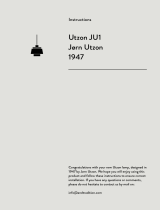
SYDNEY OPERA HOUSE
TM
Sydney, New South Wales, Australia
www.sydneyoperahouse.com
Booklet available in English on
Heft in deutscher Sprache erhältlich auf
Livret disponible en français sur
Folleto disponible en español en
Folheto disponível em português em
A füzet magyarul ezen a honlapon olvasható:
Architecture.LEGO.com
21012_BI.indd 1 13/10/2011 12:08 PM

SYDNEYOPERAHOUSE
™
Sydney Opera House is a masterpiece of late
modern architecture and an iconic building of the 20th
century. It is admired internationally and proudly treasured
by the people of Australia. It was created by a young
Danish architect, Jørn Utzon (1918-2008), who understood
the potential provided by the site against the stunning
backdrop of Sydney Harbour.
The massive concrete sculptural shells that form
the roof of Sydney Opera House appear like billowing
sails filled by the sea winds with the sunlight and cloud
shadows playing across their shining white surfaces.
Utzon envisaged it as being like to a Gothic cathedral
that people would never tire of and never be finished with.
Today Sydney Opera House does not operate solely
as a venue for opera or symphony, but also hosts a wide
range of performing arts and community activities. These
include classical and contemporary music, ballet, opera,
theatre, dance, cabaret, talks and large scale public
programs.
Since its opening in 1973 over 45 million people have
attended more than 100 000 performances, and it is
estimated that well over 100 million people have visited the
site. It is one of Australia's most visited tourist attractions,
being the most internationally recognized symbol of the
nation. Today Sydney Opera House welcomes more than
8 million visitors and presents around 2400 events a year.
Opposite page: Sydney Opera House on Bennelong Point.
© WE-EF LIGHTING 2011 Photo Ralph Alfonso
The three groups of interlocking shells
are set on a vast terraced platform.
© Michael Moy Idea to Icon
Sydney Opera House projects into
the harbour, with the central business
district of the city behind.
© Michael Moy Idea to Icon
2
21012_BI.indd 2 06/10/2011 6:32 PM

21012_BI.indd 3 06/10/2011 6:32 PM

History
The history of Sydney Opera House is as extraordinary
and complex as the building itself. It is a story of vision,
courage, dedication, challenge, controversy and triumph.
Its many remarkable elements include the
submission of a visionary design that the judges
courageously selected as the winner; the collaborative
partnership of architect and engineer that produced
ground-breaking construction solutions; the breach
created by Jørn Utzon’s departure from the project in
1966; and his re-engagement in 1999 to provide design
principles to guide Sydney Opera House into the future.
It began in 1956 when the New South Wales
(NSW) Government announced an international design
competition and appointed an independent jury. The
competition brief did not specify design parameters or
Competition drawings submitted by Jørn Utzon to the Opera House Committee;
Perspective from the staircase between the two halls looking towards the north,
1956. © State Records NSW
4
21012_BI.indd 4 06/10/2011 6:32 PM

Model of Sydney Opera House. © State Records NSW
set a cost limit. The only requirement was for a design of
two performance halls: a Major Hall for grand opera and
symphony; and a Minor Hall for drama. There was to be
additional space for experimental theatre and rehearsals.
The combination of site and brief proved irresistible:
933 competitors from all over the world registered and
233 entries were received from 28 countries. Judging
took place in January 1957 and the entry of the relatively
unknown architect, Jørn Utzon, was the unanimous winner.
Both the architectural fraternity and the public were
amazed by the design and found it to be a spectacular
response to the brief and the site.
5
21012_BI.indd 5 06/10/2011 6:32 PM

Utzon’s distinct design was comprised of sets of
interlocking vaulted ‘shells’ based upon a podium. Over
three years Utzon gradually made changes from his
original concept drawings in order to develop a way to
construct the large roof shells. While the Podium was
under construction, the geometry of the shells had not
yet been resolved from an engineering perspective. Many
options were explored, culminating in Utzon's 'spherical
solution', developed in collaboration with Ove Arup, using
segments of a single sphere. This allowed cost effective
prefabrication from a single set of moulds.
The scale of construction of Sydney Opera House
was enormous. Over 30 000 cubic metres of rock and soil
had to be removed from the site and the construction of
the shell structure required the world’s largest crane.
Construction
Models of shells. © State Records NSW
6
21012_BI.indd 6 06/10/2011 6:32 PM

From 1964 the pre-cast rib vaults of the shells began
to be erected on the completed podium. The construction
of the roof brought together some of the world's best
construction engineers and craftsmen for one of the most
difficult engineering tasks ever attempted. It was also the
first time computers were used to resolve some of the
engineering/design problems.
Sydney Opera House is a significant feat of engineering and technology
involving ingenuity and creativity in many aspects of its design and construction.
Photograph by Max Dupain and Associates
The Podium takes shape at Bennelong
Point. Photograph by Max Dupain and
Associates
Sydney Opera house during
construction. Photograph by Max
Dupain and Associates
7
21012_BI.indd 7 17/10/2011 12:56 PM

Although Utzon had spectacular plans for the interior
of the shells, he would be unable to realize this part of his
design. A change of government and growing criticism at
cost overruns led to Utzon’s withdrawal in February 1966.
By April he had left Sydney, never to return.
The NSW Government appointed a team of local
architects to complete the glass walls and interiors. The
use of the main halls was revised. The Major Hall was
dedicated to symphony and renamed the Concert Hall.
The Minor Hall was dedicated to opera and dance and
renamed the Opera Theatre. Three previously unplanned
venues were added underneath the Concert Hall on the
western side.
Sydney Opera House was formally opened by Her
Majesty Queen Elizabeth II on 20 October 1973 in front
of a large crowd. The opening was also televised and
included fireworks and a performance of Beethoven’s
Symphony No. 9.
The opening of Sydney Opera House in 1973. Photograph by Max Dupain and
Associates
8
21012_BI.indd 8 14/10/2011 1:07 PM

It would be over 30 years before the architect would
be reunited with his masterpiece. After a number of
approaches, conversations and meetings, Utzon agreed
in 1999 to be re-engaged to develop a set of Design
Principles that would act as a guide for all future changes
to the building.
The work as he saw it would be to “articulate the
overall vision and detailed design principles for the site,
and for the form of the building and its interior".
His first major project was the refurbishment of the
Reception Hall into a stunning, light filled space which
highlights the original concrete 'beams' and a wall-length
tapestry designed by him which hangs opposite the
harbour outlook. The room was renamed the Utzon Room
in his honour in 2004.
Utzon, in collaboration with his architect son Jan and
Sydney-based architect Richard Johnson, would continue
to work on a series of modern alterations right up to his
death in 2008.
© Michael Moy Idea to Icon
9
21012_BI.indd 9 06/10/2011 6:33 PM

Design
Sydney Opera House is an exceptional building. Its
architectural form comprises three groups of interlocking
vaulted ‘shells’, set upon a vast terraced podium and
surrounded by flat broadwalks that function as pedestrian
promenades.
The shells are clad in glazed off-white tiles while
the podium is clad in earth-toned, reconstituted granite
panels. The two main halls are arranged side by side,
oriented North-South with their axes slightly inclined.
The auditoria are carved out of the high north end of the
podium so that they face south, towards the city, with the
stage areas positioned between them and the entrance
foyers.
The north and south ends of the shells are hung
with topaz coloured glass walls that project diagonally
outwards to form foyers, offering views from inside and
outside. The tallest shell reaches the height of a 20-storey
building above the water. The shell structures cover nearly
two hectares and the whole site is nearly six hectares.
The matt and glossy roof tiles took three years to develop with the manufacturer.
© Michael Moy Idea to Icon
The podium is clad in earth-toned panels © Michael Moy Idea to Icon
10
21012_BI.indd 10 06/10/2011 6:33 PM

In 2007 Sydney Opera House was inscribed in
the World Heritage List: “List, described as "a great"
architectural work of the 20th century. It represents
multiple strands of creativity, both in architectural form
and structural design, a great urban sculpture carefully
set in a remarkable waterscape and a world famous
iconic building.” The expert evaluation report to the World
Heritage Committee stated: “…it stands by itself as one
of the indisputable masterpieces of human creativity, not
only in the 20th century but in the history of humankind.”
The powerful geometric forms of Sydney Opera House.
© Michael Moy Idea to Icon
Glass walls projecting diagonally outwards. © Michael Moy Idea to Icon
11
21012_BI.indd 11 06/10/2011 6:33 PM

JørnUtzon
Jørn Utzon was born on April 9 1918 in Copenhagen,
Denmark. He grew up in the town of Aalborg, where his
father was a naval architect and engineer and director of
the local shipyard. A keen sailor, Utzon originally intended
to follow his father as a naval engineer, but opted to study
Architecture at the Copenhagen Royal Academy of Arts.
[ I like to be on the edge
of the possible. ]
Jørn Utzon
12
21012_BI.indd 12 06/10/2011 6:33 PM

On graduating in 1942, he worked in Sweden until the
end of World War II. He was influenced by Gunnar Asplund
and later Alvar Aalto, with whom he worked in Finland for
a short period after the war. In 1949 he received a grant
that enabled him and his wife Lis to travel extensively in
USA and Mexico, coming into contact with some of the
most influential architects of his day, including members
of Frank Lloyd Wright’s school at Taliesin, Mies van der
Rohe, Ray and Charles Eames and Richard Neutra. He
was also in Paris meeting with Le Corbusier and the
sculptor Henri Laurens, whose influence taught him much
about form.
A major project took him to Morocco; unfortunately
the project was not realized, but he used the opportunity
to walk along the Atlas mountain range, where he was
very inspired by the indigenous adobe architecture.
He returned to Copenhagen in 1950 to open his own
architectural practice.
In 1956, after wining a number of smaller architectural
competitions, Utzon submitted his vision for Sydney Opera
House to the New South Wales Government. He was
as surprised as anyone when he actually won the competition.
His competition entry was a schematic design, clearly
explaining the concept for the building. The sketches and
‘geometrically undefined’ curves of course needed to be
developed for the building to be built. This is quite normal
for competition projects. Utzon himself was sure it could
be built and in the pioneering spirit present in Sydney at
the time, construction went ahead.
It was Utzon’s life and travels that had shaped his
ideas for Sydney Opera House. Though he had never
visited the site, he used his maritime background to
study naval charts of Sydney harbour. His early exposure
to shipbuilding provided the inspiration for the Sydney
Opera House ‘sails’ and would also help him solve the
challenges of their construction. From his travels to
Mexico, he had the idea of placing his building on a wide
horizontal platform.
After he was forced from the project by a new client
in 1966, Utzon continued to push modern architecture
[ I like to be on the edge
of the possible. ]
Jørn Utzon
13
21012_BI.indd 13 06/10/2011 6:33 PM

toward an era of freer experimentation. The principles
behind his renowned Bagsværd Church (1976) in the
suburbs of Copenhagen and his parliament building in
Kuwait (1983) can be traced directly back to his original
vision for Sydney Opera House.
The reconciliation with Sydney Opera House in 1999
brought Utzon great pleasure. In 2003, the same year the
Opera House celebrated its 30th birthday, Jørn Utzon was
awarded the Pritzker Prize for Architecture, the highest
award in its field. A year later in 2004, the newly refurbished
Reception Hall was renamed the Utzon Room in his honour.
With its wide, bare spaces, its colourful tapestry (designed
by himself), pale timbered floor and a ceiling of folded
concrete beams, it was exactly as he had dreamed it.
Jørn Utzon passed away peacefully in his sleep in
Copenhagen on 29 November 2008 aged 90. His legacy
lives on through the World Heritage listed Sydney Opera
House and his Design Principles as a permanent record
of his vision for the place, as well as the many other
magnificent structures he designed around the world.
© Michael Moy Idea to Icon
14
21012_BI.indd 14 06/10/2011 6:33 PM

FactsaboutSYDNEYOPERAHOUSE
™
Location: .......................... Bennelong Point, Sydney,
New South Wales, Australia
Architect:.......................... Jørn Utzon
Style: ................................... Expressionist
Materials: ......................... Concrete, ceramic, granite,
bronze and glass
Construction: ................ Concrete frame & precast
concrete ribbed roof with ceramic
tiles and reconstituted granite
cladding to the base
Date: ................................... From 1959 to 1973
Footprint: ......................... 1.8 hectares (4.5 acres)
Height: ............................... 67 m. (220 ft.)
Sydney Opera House and the Harbour Bridge. © Michael Moy Idea to Icon
Sydney Opera House sits on Bennelong Point, where, for
thousands of years prior to European settlement, local Aboriginal
people of the group known as the Cadigal people occupied the
land. The site was named Bennelong Point after a local Aboriginal
man known as Bennelong, was captured and subsequently
befriended by Governor Arthur Philip.
Sydney Opera House acknowledges the important history
of the Bennelong Point site and the rich contribution Aboriginal
and Torres Strait Islander cultures make to the diversity of the
Australian community.
Sydney Opera House has developed a Reconciliation Action
Plan which sets measurable targets to work towards closing the
gap between Aboriginal and Torres Strait Islander Australians
and their fellow Australians. For more information please see
www.sydneyoperahouse.com/rap
15
21012_BI.indd 15 06/10/2011 6:33 PM

1x
1x
1x
1
16
21012_BI.indd 16 06/10/2011 6:33 PM

1x
1x
1x
2
“The architect's gift to
society is to bring joy
to the people from the
surroundings he creates”
Jørn Utzon
© Michael Moy, Idea to Icon
17
21012_BI.indd 17 17/10/2011 12:38 PM

1x
1x
3
18
21012_BI.indd 18 06/10/2011 6:33 PM

1x
4
19
21012_BI.indd 19 06/10/2011 6:33 PM

1x
5
20
21012_BI.indd 20 06/10/2011 6:33 PM
Page is loading ...
Page is loading ...
Page is loading ...
Page is loading ...
Page is loading ...
Page is loading ...
Page is loading ...
Page is loading ...
Page is loading ...
Page is loading ...
Page is loading ...
Page is loading ...
Page is loading ...
Page is loading ...
Page is loading ...
Page is loading ...
Page is loading ...
Page is loading ...
Page is loading ...
Page is loading ...
Page is loading ...
Page is loading ...
Page is loading ...
Page is loading ...
Page is loading ...
Page is loading ...
Page is loading ...
Page is loading ...
Page is loading ...
Page is loading ...
Page is loading ...
Page is loading ...
Page is loading ...
Page is loading ...
Page is loading ...
Page is loading ...
Page is loading ...
Page is loading ...
Page is loading ...
Page is loading ...
Page is loading ...
Page is loading ...
Page is loading ...
Page is loading ...
Page is loading ...
Page is loading ...
Page is loading ...
Page is loading ...
Page is loading ...
Page is loading ...
Page is loading ...
Page is loading ...
Page is loading ...
Page is loading ...
Page is loading ...
Page is loading ...
Page is loading ...
Page is loading ...
Page is loading ...
Page is loading ...
Page is loading ...
Page is loading ...
Page is loading ...
Page is loading ...
-
 1
1
-
 2
2
-
 3
3
-
 4
4
-
 5
5
-
 6
6
-
 7
7
-
 8
8
-
 9
9
-
 10
10
-
 11
11
-
 12
12
-
 13
13
-
 14
14
-
 15
15
-
 16
16
-
 17
17
-
 18
18
-
 19
19
-
 20
20
-
 21
21
-
 22
22
-
 23
23
-
 24
24
-
 25
25
-
 26
26
-
 27
27
-
 28
28
-
 29
29
-
 30
30
-
 31
31
-
 32
32
-
 33
33
-
 34
34
-
 35
35
-
 36
36
-
 37
37
-
 38
38
-
 39
39
-
 40
40
-
 41
41
-
 42
42
-
 43
43
-
 44
44
-
 45
45
-
 46
46
-
 47
47
-
 48
48
-
 49
49
-
 50
50
-
 51
51
-
 52
52
-
 53
53
-
 54
54
-
 55
55
-
 56
56
-
 57
57
-
 58
58
-
 59
59
-
 60
60
-
 61
61
-
 62
62
-
 63
63
-
 64
64
-
 65
65
-
 66
66
-
 67
67
-
 68
68
-
 69
69
-
 70
70
-
 71
71
-
 72
72
-
 73
73
-
 74
74
-
 75
75
-
 76
76
-
 77
77
-
 78
78
-
 79
79
-
 80
80
-
 81
81
-
 82
82
-
 83
83
-
 84
84
Lego 21012 Architecture Building Instructions
- Type
- Building Instructions
- This manual is also suitable for
Ask a question and I''ll find the answer in the document
Finding information in a document is now easier with AI
Related papers
Other documents
-
 Mayco Industries Inc 00101 User manual
Mayco Industries Inc 00101 User manual
-
 &Tradition Utzon JU1 User manual
&Tradition Utzon JU1 User manual
-
 &Tradition Utzon JU1 User manual
&Tradition Utzon JU1 User manual
-
Pro-Ject S2 Dream Team Offer
-
Progress Lighting P300084-078 Operating instructions
-
Horizon Fitness XF40 Exploded Diagram
-
 Enabling Devices 1049W User manual
Enabling Devices 1049W User manual
-
Progress Lighting P300085-009 Operating instructions
-
Progress Lighting P300085-078 Operating instructions
-
Ralph Lauren RR112-04 Operating instructions























































































